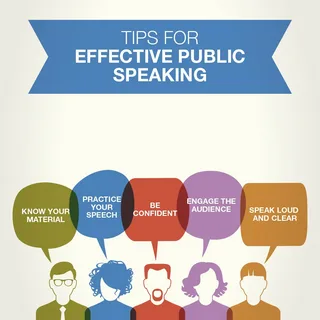Public speaking is something many people fear, but it is manageable if you follow the right strategies. The initial steps include knowing your audience and the flow of your speech. With practice, you fine-tune your delivery and ensure active body language to leave an impact. You have to manage the pressure you are feeling to handle nerves and use visuals to deliver your message better. Furthermore, an organized speech is one that people can follow, while audience engagement is the key to keeping their attention from start to end. Finally, seek feedback from your audience and improve yourself considering their remarks. You can build a powerful presence by taking the right steps while speaking in front of the public. A confidence coach can offer professional help to let you face public fear and overcome the challenges.
Tips For Public Communication
Follow these public speaking tips to enjoy a smoother experience:
-
Know Your Audience
If you are going to give a good speech then you need to know your audience. Take into account who they are, what they’re curious about, how much they know about the subject. In case you speak with professionals, you have to speak their industry language. But if you expect a general audience, make sure to keep your explanations simple and relatable, which results in an engaging and effective speech.
-
Practice Regularly
It helps you deliver your speech smoothly. Rehearse in front of a mirror, record yourself, or present to a friend for feedback. The more you practice, the more assurance you can gain when you actually have to face the audience.
-
Master Your Content
You should know the topic really well as it gives you confidence and lets you talk in a more natural way. Instead of memorizing your speech word for word, know what you’re saying well enough so that you can adjust to your audience’s reactions and questions. It also aids you in getting back on track if you lose track in your speech.
-
Work on Your Delivery
What you say is just as important as how you say it. Ensure you are speaking clearly, at the right pace, and in a variety of tones to retain your audience in the message you are giving. Avoid delivering filler speech such as “um,” “uh,” or “like,” which can make you seem less confident.
-
Use Body Language Effectively
Make eye contact to engage your audience, make hand gestures to emphasize points, and stand properly to look confident. Do not portray nervous gestures, such as fidgeting, pacing, or crossing your arms.
-
Engage Your Audience
A speech should be like a conversation, not like a lecture. You can prompt questions, open the floor for personal stories, or be funny and relatable. By involving your audience, your key points are more likely to stick with them and hold their interest.
-
Control Your Nerves
It’s normal to feel nervous before speaking, but preparation can make all the difference. Breathe deeply and remember that your audience would prefer you confident. Instead of letting your nervous energy make you anxious, use it to fuel your enthusiasm for your topic.
-
Structure Your Speech Well
An organized speech is easier for your audience to keep track of. Start with a good opening (hook), a clear outline of key points, followed by a strong conclusion. Deliver your speech with real-world examples and stories.
-
Use Visual Aids Wisely
Slides, props, and videos can add a lot to your presentation, but they should complement your message, not distract from it. Make sure your visual content is concise, relevant, and crystal clear. Do not read off of slides as this makes your speech very monotonous.
-
Get Feedback and Continue to Improve
You will get better if you practice and receive constructive criticism. Seek feedback from colleagues, mentors, or audience members after your speech. So, observe what worked and what did not, and you will learn to perform better in your next presentation.
Read more: How to Use Automation to Make Your Marketing Smarter and More Effective
Which Gestures Are Better While Giving A Presentation?
Keep your shoulders and back straight while looking out at the audience, at public speaking events for better delivery of gestures. Work on nervous expressions (pacing, crossing your arms, etc.) as these signal discomfort. Nervousness is normal but you can use that energy to fuel your topic. Deep breaths and positive self-talk can help overcome nervous energy.
Conclusion
With practice and dedication, you can develop your public speaking skills. Knowing your audience and preparing a well-structured speech is a great start. Confidence is improved by lots of practice, confident body language, and good pressure management. Effective use of visual aids keeps your presentation interesting, while a well-structured speech allows your message to be understood easily. The more you engage with your audience, the more impactful your speech is. Feedback on your performance helps you get better with time. You can be a great public speaker through practice and following the right strategies. A confidence coach can help you strengthen your skills through professional guidance to achieve lasting confidence.


